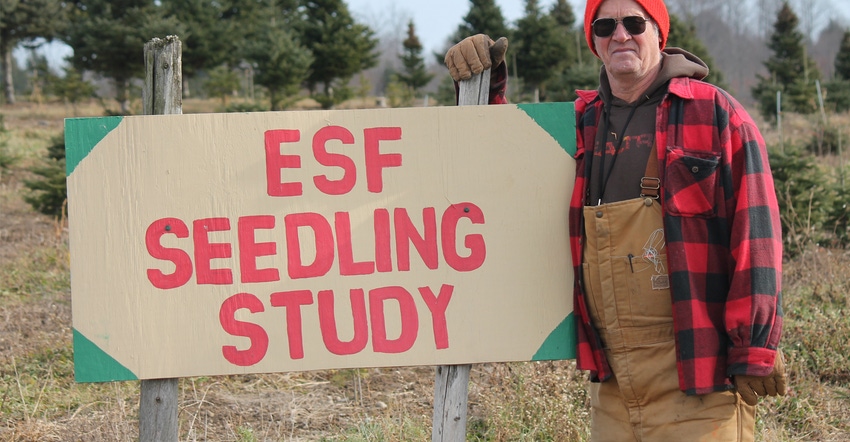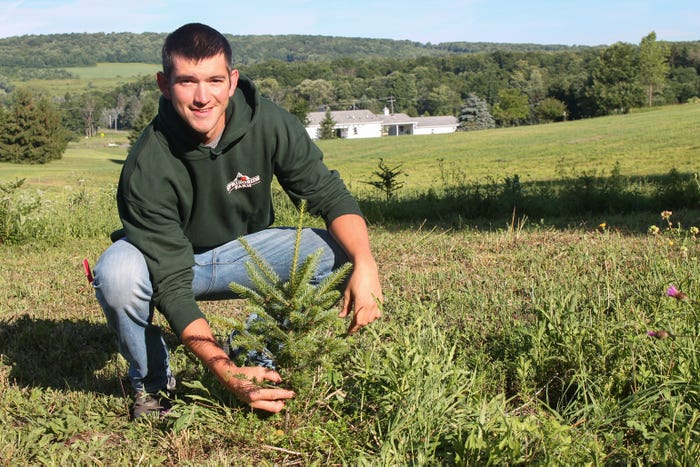August 21, 2018

Phytophthora root rot poses a significant financial threat to the Christmas tree industry in New York state. According to 2012 data, New York state had nearly 19,000 acres planted across 1,185 farms, making it the sixth-largest Christmas tree producer in the nation.
In 2015, Phytophthora's advance against the popular Fraser fir prompted an evaluation of the Mediterranean Turkish fir as a less-susceptible alternative.
The Christmas Tree Farmers Association of New York estimates that, if Turkish fir could be successfully grown in New York state, the annual revenue potential for a 15,000-tree farm with 30% Turkish fir could be $263,000. The trees are thought to be especially suited for use on underutilized acres with heavy, wet soil.
With a New York Farm Viability Institute grant, Russell D. Briggs, director of the Division of Environmental Science at the College of Environmental Sciences and Forestry in Syracuse, worked with Travis Drexler of Springside Farm in Fabius and eight other growers to evaluate Turkish fir, as little research had been done previously to assess its true potential.
 FIR PROGRESS: Travis Drexler shows how much the Turkish firs have grown since planting in 2015.
FIR PROGRESS: Travis Drexler shows how much the Turkish firs have grown since planting in 2015.

"We need research to help us manage the challenges of disease, pests and tree loss," Drexler says.
In 2015, he set aside land for an experimental planting of 100 Turkish firs.
"It was logical to try Turkish fir because it is less prone to Phythopthora. A mature Turkish fir can be a beautiful tree with the soft, high-quality foliage that consumers want," he says.
The trial compared the survival of the Turkish fir vs. Fraser fir on different soil types in different regions of the state, and in plots designed to fit individual farm management protocols.
"We planted this trial on nice ground because if a tree won't grow on your best ground, it won't grow on your worst," he says. "We want whatever we plant to have the best opportunity to return per acre."
After three years of research, Springside Farm had the best survival rate of both species. Ninety-five percent of the Frasers remained while 83% of the Turkish firs remained but were much shorter.
 YOUNG TURKISH FIR: Travis Drexler points out young Turkish fir trees. His operation, Springside Farm also participated in the Turkish fir study.
YOUNG TURKISH FIR: Travis Drexler points out young Turkish fir trees. His operation, Springside Farm also participated in the Turkish fir study.

"Turkish fir is naturally slow growing, however, the national demand to try it put us at a greater disadvantage. The stock we received was very small and arrived a little past our usual planting time. The Frasers were twice the height at planting," Drexler says.
Briggs and his research team managed fertilization of the plots.
"The use of slow-release nitrogen did not produce any significant differences. Foliage sampling for tissue N was consistently higher with the Turkish firs, but varied by farm," Briggs says.
While one farm pulled the Turkish firs to replace with a proven species, Drexler is letting his grow.
"It would be unfair to attribute loss just to the variety. A number of factors influenced this trial. I will extend evaluation until the trees reach a cutting height, so we are leaving the planting in," he says.
Drexler also has a Plan B.
"The fluffy needles that make the Turkish firs sell as trees also make great wreaths, which return a higher value per tree," he says. "Opportunities like this Turkish fir project are important to the tree industry. By committing not even a half-acre to the research trials to learn that a variety may not work as well as hoped represents a potentially significant financial savings had we jumped in with a large planting based on the thought that this was next great hope for our industry."
John Fowler was hoping Turkish fir would grow well in trouble spots at his Grace Farms in Central Square. He interplanted Turkish firs in harvested openings among his mature trees.
"We have replaced half-a-dozen Frasers every year for several years and have tried several different species on our downsloping land on poorer ground," Fowler says.
Although the farm's Turkish firs grew to the largest diameter in the trial and had the second-highest survival rate vs. Frasers, they did not do well enough to join the farm's cropping plan.
"This trial was worthwhile for what we gained from Russ Briggs' experience and expertise, learning what we can do to grow the farm into the future," Fowler says. "We need hardy trees that can handle extreme changes from wet to drought years, flooding to heavy snow.
"We will not plant any more Turkish firs, but we now know more about caring for the species we are focused on, including Fraser, Canaan and concolor. We needed this science-based evaluation to know which direction is best for us, and it shows the people who prefer real trees that as growers we are working closely with researchers to supply customers' needs as growing conditions change."
 FAMILY LEGACY: Kendra Franke of Franke Farms in Marion, N.Y., stands next to a Turkish fir on display at the recent Empire Farm Days. Her grandfather began growing Turkish firs in 1974. She and her father, Ken, have continued the legacy, growing the trees from seed collected from the now 60-foot trees.
FAMILY LEGACY: Kendra Franke of Franke Farms in Marion, N.Y., stands next to a Turkish fir on display at the recent Empire Farm Days. Her grandfather began growing Turkish firs in 1974. She and her father, Ken, have continued the legacy, growing the trees from seed collected from the now 60-foot trees.

The poorest survival and growth for Turkish fir occurred on sites characterized by relatively high soil pH and high extractable phosphorus, which results in small height and diameter.
Project collaborators included Cornell University, Cornell Cooperative Extension and Penn State University.
For more information, contact Russ Briggs at 315-470-6989 or [email protected].
Dunn writes from her farm in Mannsville. N.Y.
About the Author(s)
You May Also Like




